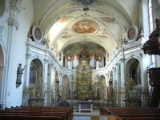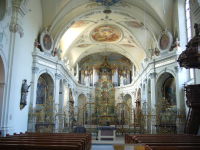
Fischingen Abbey
Encyclopedia
Fischingen Abbey now Fischingen Priory, is a Benedictine monastery situated in Fischingen in the Canton of Thurgau, Switzerland
, on the upper reaches of the Murg, a tributary of the Thur
. It was founded in 1138, dissolved in 1848 and re-founded as a priory in 1977.
 The abbey was founded in 1138 by Ulrich II, Bishop of Constanz as a private episcopal monastery, with the intention that it should offer shelter and hospitality to pilgrims on their way from Constanz to Einsiedeln Abbey
The abbey was founded in 1138 by Ulrich II, Bishop of Constanz as a private episcopal monastery, with the intention that it should offer shelter and hospitality to pilgrims on their way from Constanz to Einsiedeln Abbey
.
The hermit Gebino was appointed the first abbot. In only six years he had had built a bell tower, accommodation for both monks and nuns, and a guesthouse. At its high point in about 1210, Fischingen had about 150 monks and 120 nuns. The "Vogtei
" (protective lordship) over the abbey belonged to the Counts of Toggenburg
. Saint Idda of Toggenburg, who lived in a cell of the abbey in about 1200, is buried in a chapel off the abbey church.
From 1460 the abbey was under the authority of the administration of Thurgau
in the Old Swiss Confederacy
.
During the Reformation
, the abbey was dissolved for several years, when in 1526 the abbot and the four remaining monks converted to the Reformed
beliefs. The abbey was reopened however on the initiative of the Roman Catholic townships of the Old Swiss Confederacy
.
In the 17th and 18th centuries the premises were rebuilt in the Baroque
and Rococo
styles. Between 1685 and 1687 a new abbey church was constructed, and in 1705 a new chapel dedicated to Saint Idda. In the 18th century part of the monastic premises was rebuilt, but could not be completed because of the abbey's accumulated debts.
Fischingen Abbey was dissolved on 27 June 1848 by the Grand Council of Thurgau.
After the repeal in 1973 of the so-called "Article of exception" ("Ausnahmeartikel") in the Swiss constitution, which forbade the opening of new monasteries and the re-establishment of old ones, Fischingen was reopened as an independent priory in its former premises in 1977.
In 1602 Fischingen joined the then newly-established Swiss Congregation
, now part of the Benedictine Confederation
, and re-joined on its re-foundation in 1977.
Switzerland
Switzerland name of one of the Swiss cantons. ; ; ; or ), in its full name the Swiss Confederation , is a federal republic consisting of 26 cantons, with Bern as the seat of the federal authorities. The country is situated in Western Europe,Or Central Europe depending on the definition....
, on the upper reaches of the Murg, a tributary of the Thur
Thur
Thur may refer to:*Thur River , a river in Alsace, France*Thur River , a river in East Switzerland* Thursday, as an abbreviation...
. It was founded in 1138, dissolved in 1848 and re-founded as a priory in 1977.
History

Einsiedeln Abbey
Einsiedeln Abbey is a Benedictine monastery in the town of Einsiedeln in the Canton of Schwyz, Switzerland. The abbey is dedicated to Our Lady of the Hermits, the title being derived from the circumstances of its foundation, from which the name Einsiedeln is also said to have originated...
.
The hermit Gebino was appointed the first abbot. In only six years he had had built a bell tower, accommodation for both monks and nuns, and a guesthouse. At its high point in about 1210, Fischingen had about 150 monks and 120 nuns. The "Vogtei
Vogtei
Vogtei could be:* The residenz or domain of a Vogt* Vogtei , a municipal association in the Unstrut-Hainich district of Thuringia, Germany....
" (protective lordship) over the abbey belonged to the Counts of Toggenburg
Counts of Toggenburg
The Counts of Toggenburg ruled the Toggenburg region of today's Canton of St. Gallen, Switzerland, as well as parts of the Canton of Glarus, Thurgau, Grisons, Vorarlberg, and Zurich when their influence was most extensive....
. Saint Idda of Toggenburg, who lived in a cell of the abbey in about 1200, is buried in a chapel off the abbey church.
From 1460 the abbey was under the authority of the administration of Thurgau
Thurgau
Thurgau is a northeast canton of Switzerland. The population, , is . In 2007, there were a total of 47,390 who were resident foreigners. The capital is Frauenfeld.-History:...
in the Old Swiss Confederacy
Old Swiss Confederacy
The Old Swiss Confederacy was the precursor of modern-day Switzerland....
.
During the Reformation
Protestant Reformation
The Protestant Reformation was a 16th-century split within Western Christianity initiated by Martin Luther, John Calvin and other early Protestants. The efforts of the self-described "reformers", who objected to the doctrines, rituals and ecclesiastical structure of the Roman Catholic Church, led...
, the abbey was dissolved for several years, when in 1526 the abbot and the four remaining monks converted to the Reformed
Reformed churches
The Reformed churches are a group of Protestant denominations characterized by Calvinist doctrines. They are descended from the Swiss Reformation inaugurated by Huldrych Zwingli but developed more coherently by Martin Bucer, Heinrich Bullinger and especially John Calvin...
beliefs. The abbey was reopened however on the initiative of the Roman Catholic townships of the Old Swiss Confederacy
Old Swiss Confederacy
The Old Swiss Confederacy was the precursor of modern-day Switzerland....
.
In the 17th and 18th centuries the premises were rebuilt in the Baroque
Baroque
The Baroque is a period and the style that used exaggerated motion and clear, easily interpreted detail to produce drama, tension, exuberance, and grandeur in sculpture, painting, literature, dance, and music...
and Rococo
Rococo
Rococo , also referred to as "Late Baroque", is an 18th-century style which developed as Baroque artists gave up their symmetry and became increasingly ornate, florid, and playful...
styles. Between 1685 and 1687 a new abbey church was constructed, and in 1705 a new chapel dedicated to Saint Idda. In the 18th century part of the monastic premises was rebuilt, but could not be completed because of the abbey's accumulated debts.
Fischingen Abbey was dissolved on 27 June 1848 by the Grand Council of Thurgau.
After dissolution
The abbey premises were sold in 1852 to a textile factory. Later a business and trade school was set up here. In 1879 the buildings were acquired by the Catholic voluntary society "Verein St. Iddazell", who established in them the St. Iddazell orphanage.After the repeal in 1973 of the so-called "Article of exception" ("Ausnahmeartikel") in the Swiss constitution, which forbade the opening of new monasteries and the re-establishment of old ones, Fischingen was reopened as an independent priory in its former premises in 1977.
In 1602 Fischingen joined the then newly-established Swiss Congregation
Swiss Congregation
The Swiss Congregation of the Benedictine Confederation is a grouping of Benedictine monasteries in Switzerland or with significant historical Swiss connections.-Foundation:...
, now part of the Benedictine Confederation
Benedictine Confederation
The Benedictine Confederation of the Order of Saint Benedict is the international governing body of the Order of Saint Benedict.-Origin:...
, and re-joined on its re-foundation in 1977.

